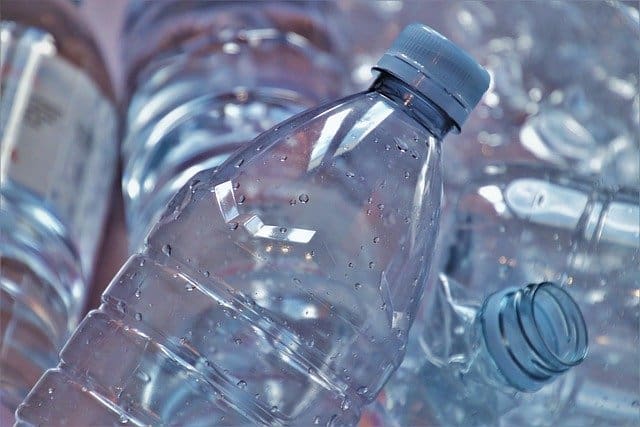Picture this – You just finished a long workout. You’re absolutely PARCHED. You reach into your gym bag and – oh no! – you realize you forgot your reusable water bottle. You run to the vending machine, buy a bottle of water, chug it, and toss it in the trash seconds later. You know single use plastics are bad and take forever to degrade, but you figure one bottle isn’t going to matter in the scheme of things. You don’t think much more about it.
Now picture this – Millions of other people just did the exact same thing as you. Oh, if only you knew the journey that bottle took to reach that vending machine.
It’s time to have the talk… about plastic’s carbon footprint.

How many single-use plastic water bottles do you use per day? Per week? Per year? According to the Container Recycling Institute, roughly 315 bottles per person were sold in the US in 2014. By this metric, it looks like most people consume one plastic water bottle per day. For one person, this isn’t much. For 328 million US citizens, collectively the numbers start to add up.
Maybe you have heard the spiel about throwing away single-use plastics (there is no “away”). Maybe you know that it takes roughly 1000 years for a plastic water bottle to decompose. Maybe you know there is a huge floating mass of plastics and other trash in the Pacific ocean twice the size of Texas (affectionately known as “The Great Pacific Garbage Patch” or “GPGB”).
But did you know your water bottle is made from some of the same chemicals found in oil/fossil fuels?
That’s right, your plastic bottle that you thought would, in a worst case scenario, only add one more little piece to the Great Pacific Garbage Patch, has a carbon footprint. Not only that, it has a relatively big one.
A Step-By-Step Breakdown of the Life Cycle of a Plastic Bottle
Let’s break down the emissions associated with a single plastic bottle one-by-one by learning about its life cycle. Each step will be summed up in the first few sentences of each bullet point. For those of you nosy folks who want more technical information, I’ll add details in parenthesis after the basic info!
1.) Before your plastic bottle is born, the chemicals that make it up are found deep within the ground. They can be extracted via drilling or, a newer technology, fracking. (Let’s assume we are making a standard water bottle. These are usually made from a plastic called polypropylene. The main chemical we are interested in extracting to create this type of plastic is propane. This is a carbon based chemical. You may be familiar if you have ever grilled or watched King of the Hill.)
Emissions: Fracking releases methane! Methane is a much more potent greenhouse gas than carbon dioxide.
2.) Now that our chemical is extracted, we have to purify it. Purification happens at a plant. Most plants burn natural gas to generate energy. (When we take propane from the ground, it is mixed with other carbon-based chemicals. These are called “hydrocarbons” in industry. Each hydrocarbon has many special applications but must be separated and purified before they can be used for anything other than fuel. Propane is no different.)
Emissions: Burning natural gas releases carbon dioxide (a greenhouse gas), Nitrogen and Sulfur Oxides (sources of smog and acid rain).
3.) Next, we send pure chemical to a plant that heats it up to roughly 1500°F which causes it to react and turn into a new chemical. Think about how hot that is. Your oven is rarely going to go above 500°F. It takes a lot of energy to heat up our chemical to 3x the max temperature of your oven at home. Once we make our new chemical, we have to purify it again. (Pure propane is sent through huge furnaces and heated up to this temperature so it will react and become “propylene,” another type of hydrocarbon that we need to make our plastic.)
Emissions: More burning natural gas, and lots of it.
4.) Up next, we send our new, pure chemical to another plant where it goes through another chemical reaction and finally, we have plastic. It’s not in the shape of a water bottle yet. (This is the plant where propylene becomes “polypropylene.” The end result is little tiny pellets of plastic.)
Emissions: More burning natural gas. We should also account for the emissions related to transportation by train or truck.
5.) Finally, the plastic pellets are shaped into the plastic bottles we are familiar with through a process called blow molding. This requires energy too, but it’s usually electricity. However, most electricity is made in power plants from burning, you guessed it, natural gas.
Emissions: Probably burning natural gas, so more carbon dioxide. Transportation of water bottles to stores should be included here too. Burning gas means more carbon dioxide.
6.) The finished water bottle is filled with water and sent to the store. You buy it, drink it, then throw it away. It spends 1000 years degrading in a landfill.
Emissions: Transportation. Lots of carbon dioxide.
***Alternate ending: You recycle.
Emissions: Recycling itself still requires energy. You may be lessening plastic waste, but you’re still emitting a good bit of carbon dioxide.
The Bottom Line
So now you know all of the work and energy that goes into manufacturing a product that is only used once, but how much does this really contribute to climate change?
According to sciencing.com, the manufacturing of one 16.9 ounce water bottle produces 3 ounces of carbon dioxide. This means the average person using 315 single-use bottles per year is responsible for the release of 59 lbs (945 ounces) of carbon dioxide into the atmosphere from water bottle usage alone. With 328 million citizens in the US, this amounts to 9.67 tons (19,352 lbs) of carbon dioxide per year. This number may seem small compared to the estimated 5 billion+ tons emitted by the US in 2018 (according to the EPA), but this is just one of many plastic products we use nearly daily in the US and across the globe.
And here’s the thing… every product made from plastic has a carbon footprint. It all starts to add up! Reuse is ALWAYS the best option.
I Challenge You
Next week, start paying attention to all of the plastic you use in a day. How much of it do you throw away? How many products are made of plastic that you have never even thought about? How can you reduce your plastic waste?

